Just for a moment, suppose that; Albert Einstein was never born. Well, don’t deny his existence. Assume that he never worked in the field of physics, simply continued his life as a patient examiner at the swiss patient office. If that had happened in a reality, most of the modern technology will vanish from our life including A laser Diode.
Don’t get me wrong. I mean, I don’t deny that the actual diode laser was developed by an American engineer and physicist Robert N. Hall in the early 1960s. On the other hand, I also won’t deny the fact that it was Albert Einstein who establishes the theoretical foundation of a Laser diode (Laser) and, of course, MASERs too.
So with this argument, I can conclude; that without the foundational groundwork of a laser diode, simply putting Einstein’s Coefficient for stimulated emission; a laser diode would be impossible to construct. Here are some questions you should be asking about laser diode.
- What Is A Laser Diode?
- Laser v/s LED
- Construction Of Laser Diode
- Working Of Laser Diode
- Types Of Laser Diodes
- Laser Diode Characteristics Curve
- Advantages Of Laser Diode
- Disadvantages Of Laser Diode
- Applications Of Laser Diode
What is a Laser Diode?
A laser diode is a typical kind of PIN diode that generates a highly coherent and intense beam of light of the same frequency and phase. As I said in the introductory paragraph, the laser diode principle depends on LASER – an acronym for Light Amplification by Stimulated Emission of Radiation.
That’s why I said, without stimulated emission in a laser, a laser diode won’t work. Otherwise, it would be a light-emitting diode; not a laser diode. Before going ahead to the construction part, I shall tell you the main difference between LEDs and Laser Diode.
Editor’s Choice: What are Conductors? – Definition, Types, Facts & Examples
Laser v/s LED
- If I talk about laser diode, it emits light of a single wavelength and the same phase, that’s why they are highly coherent and monochromatic in nature. On the other hand, LED emits light of multiple wavelengths, that’s why light emitted by LED is incoherent.
- If I talk about laser diodes, their junction area is extremely narrow. On the other hand, in the case of LED, the junction area is quite wider as compared to lasers. That’s why a laser diode has a small bandwidth with highly concentrated light, and LED has wider bandwidth with less concentrated light.
- If I talk about laser diodes, they are more powerful and operate at a very high speed. On the other hand, LEDs are not that powerful and also operate at speeds much lower than the operating speed of a laser diode.
- The last but main difference between LED and a laser diode is their working principle. If I talk about laser diodes, they work on the principle of stimulated emission. On the other hand, LED works on the principle of Electro-luminance.
Construction of Laser Diode
Well, as I said previously about laser diode that it is a typical kind of PIN diode. PIN diode – a semiconductor diode made of P-type of material, intrinsic, and, N-type of material. In a semiconductor laser diode, the layers of P-type and N-type of material are made up of Gallium Arsenide (GaAs) like materials doped with materials like Selenium, silicon, or simply aluminum. On the other than, the central layer that is sandwiched between P and N-type of material is intrinsic in nature.
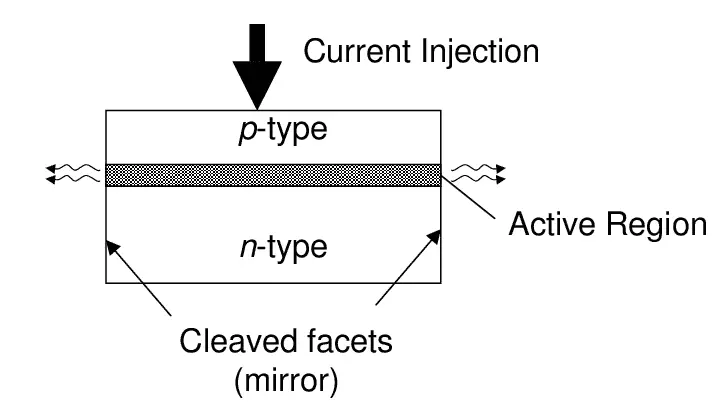
The main purpose of the sandwiching central (intrinsic) layer between the P and N-type of material is to increase the area of the active region (a region where the process of recombination takes place). Therefore, as a result, more and more electrons can recombine with holes to produce better output power.
One thing I forgot to mention; is that, the above construction detail is of the basic kind of semiconductor laser diode or you can say a homojunction laser diode. Apart from this, there are other types of laser diodes too, which we will discuss in the section specially dedicated to the types of laser diodes. But before that, let me tell you How a Laser Diode Works?
Working of Laser Diode
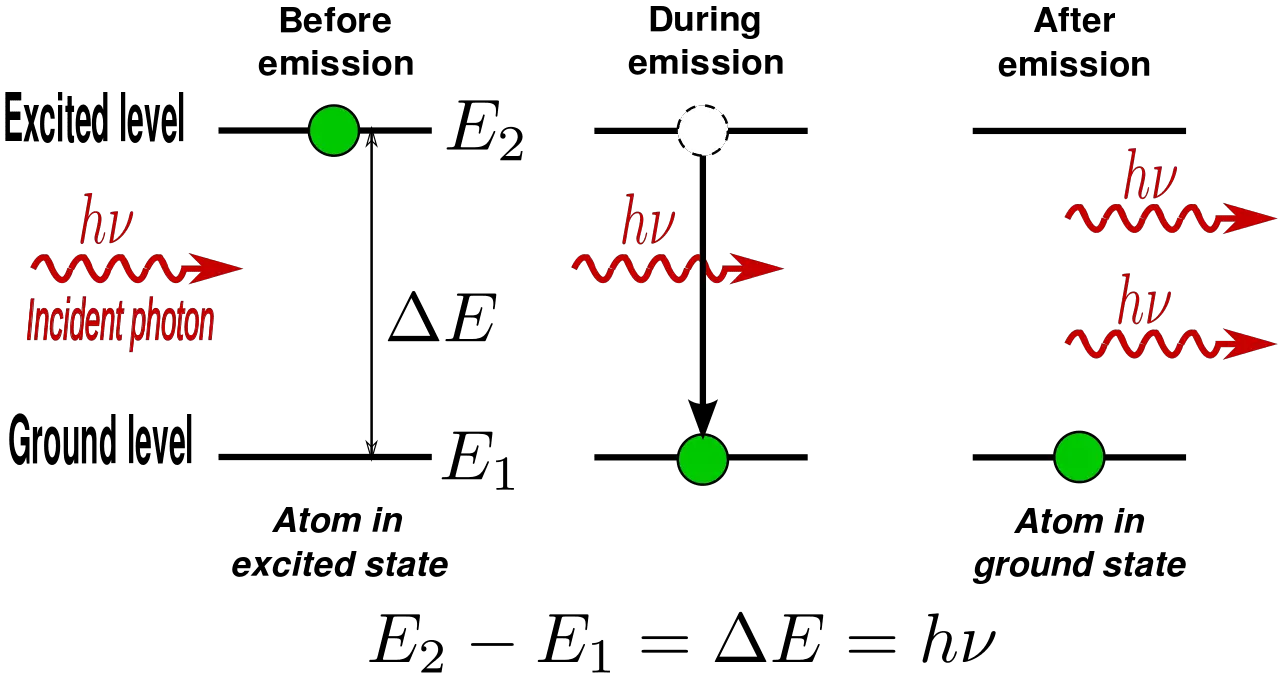
The laser diode principle basically depends upon three different kinds of phenomena i.e Absorption of Light, spontaneous emission of light, and, stimulated emission of light. Well, there is one more phenomenon that plays a special role in the working of laser diodes. But I will tell you about that when the right time comes.
Absorption of Light
The first step for the proper working of the laser diode is the Absorption of light. When some external source of energy is provided to the p-n junction of a diode laser, the electrons in the lower energy level get excited. Therefore, as a result, the electrons from the lower energy level jumps to a higher energy level. this whole process of excitation of electrons to transit from lower-level i.e valence band to higher level i.e conduction band; due to application of some external source of energy is known as absorption of light.
Spontaneous Emission of Light
The second step for the proper working of a laser diode is the Spontaneous emission of light. As of now, you know that the electrons were excited by some external source and therefore, jumped from the lower energy level to the higher energy level. But it is a well-known fact that it can’t stay there forever. I mean to say that nothing can be excited forever. Can you??? NO. So, in order to achieve stability, while shifting down from the higher energy level to the lower energy level; electrons will release some energy in the form of a photon.
The energy of the emitted photon (spontaneous emission) will be equivalent to the energy difference of the two energy levels i.e higher and lower energy levels. This whole process of electron shifting from a higher energy level to a lower energy level by emitting a photon is known as the Spontaneous emission of light. the same process is applied in LEDs to produce light.
Stimulated Emission of Light
The third and most important step for the proper working of a laser diode is the Stimulated emission of light. In order to get more coherent and monochromatic light, we need to increase the quantity of the generated photons. That’s why partially reflecting mirrors are incorporated on either side of the junction diode (see the construction figure). As a result, the photons generated during spontaneous emission in the laser will get trapped inside the junction diode.
see also, A Brief Introduction To Compton Effect
When these trapped photons strike the electrons at the higher energy levels; it will stimulate them (electrons) to combine with holes even before their recombination time. Hence releasing an additional photon. This whole process of trapping a photon and its excitation of electrons at higher energy levels; to release an additional photon is known as stimulated emission of light. Now is the perfect time to tell you about one more specific phenomenon that plays an important role in the working of laser diode i.e Population Inversion.
Population Inversion
Well, I won’t say that population inversion in the laser is the fourth step for the proper working of the laser diode. Simply because it is somehow a part of stimulated emission in laser. When the population of electrons is more at the high energy level as compared to the ground state energy level; more and more photons will be generated due to the stimulated emission in the laser.
As a result, when the concentration of photons (due to spontaneous and stimulated emission) goes above the threshold, they will finally get escaped from the partially reflecting mirror surface. Hence, resulting in a bright, coherent, and monochromatic beam of light.
Note: Now you know why I said that without stimulated emission, a laser diode won’t work. Otherwise, it would be a light-emitting diode; not a laser diode.
Types of Laser Diodes
Well, there are various types of laser diodes depending on the fact that how they are constructed. The one which I explained in the section titled “Construction Of Laser Diode” is the simplest of its kind. Hence called a homojunction laser diode.
Double Heterostructure Laser Diode
Apart from the homojunction laser diode, the next in the line of different types of laser diodes is a double heterostructure laser diode. In order to make it more efficient as compared to the homojunction laser diodes; an additional confinement layer of low bandgap material is sandwiched between the pair of high bandgap material ( see figure). Each of the junctions between different bandgap materials is called a heterostructure. And here we have two heterostructures i.e a pair of low bandgap material and a pair of high bandgap material.
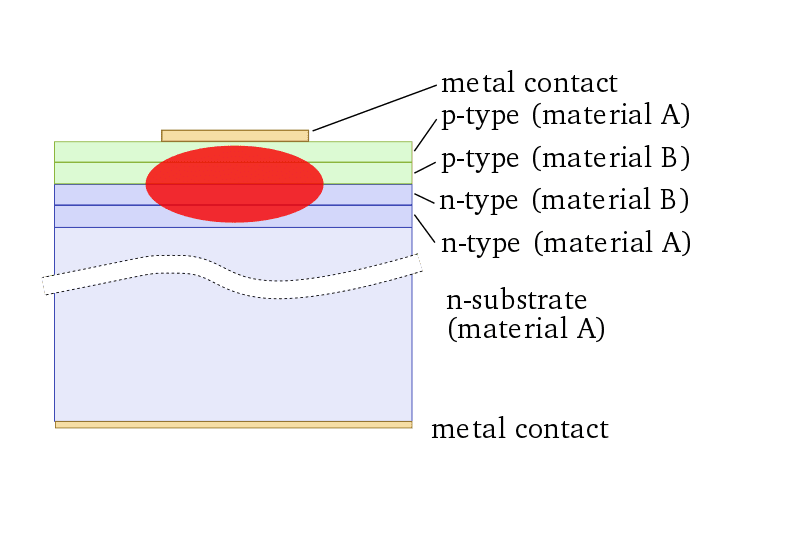
Therefore, these types of laser diodes go by the name double heterojunction laser diodes. You would be wondering why you should prefer D.H laser diode over homojunction laser diode? I would say that because of the D.H structure; its active region is confined to a more thin layer resulting in better amplification of light as compared to homojunction laser diodes.
Must Read: What are Insulators? – Definition, Types & Examples
Quantum Well Laser Diode
After a double heterojunction laser diode, the next in the line of different types of laser diodes is quantum well laser diode. See the funda is quite simple and clear. If the intrinsic (active region) layer is quite thin, it will behave as a quantum well. Hence the energy is quantized for electrons while shifting from higher energy levels to the ground state energy level.
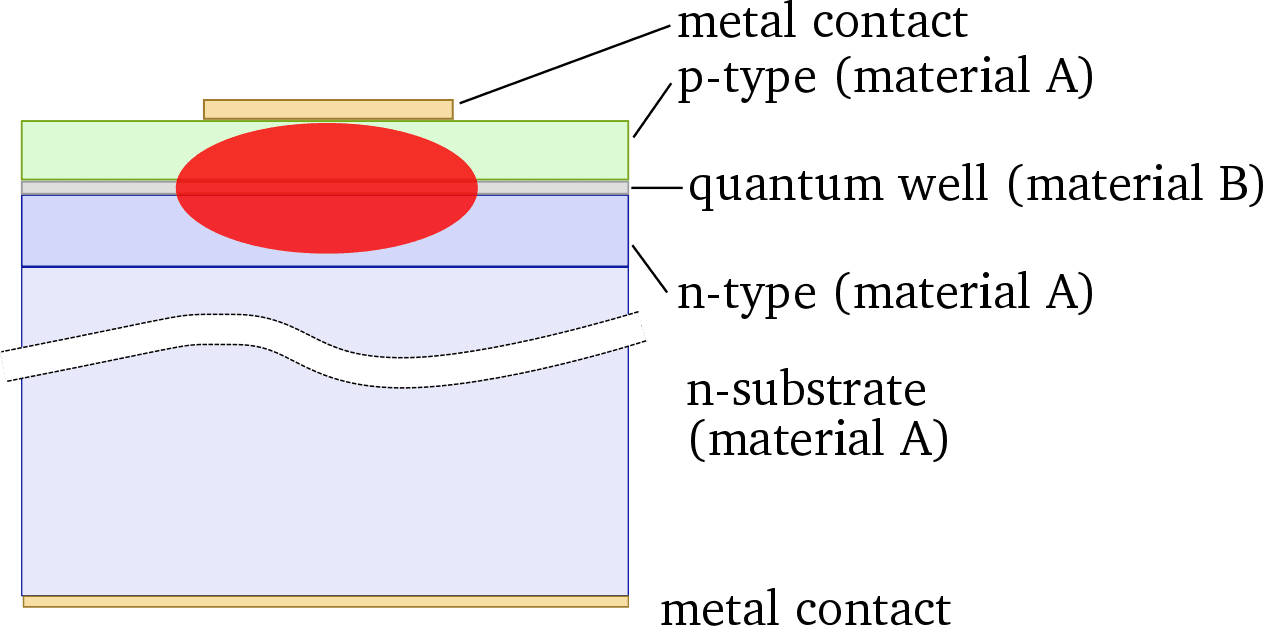
In addition, when these types of laser diodes have one quantum well, we call it a single quantum well laser diode. on the other hand, when these types of laser diodes have more than one or multi-quantum well, we call it a multiple quantum well laser diode. In other words, the more the number of quantum wells, the better will be the efficiency of a laser diode.
Separate Confinement Laser Diode
After quantum well laser diode, the next in the line of different types of laser diodes is the Separate confinement laser diode. Well, frankly speaking, it’s nothing just an updated version of a quantum well laser diodes. Let me explain how. The quantum well region of the quantum well laser diode is simply too small to effectively confine the light.
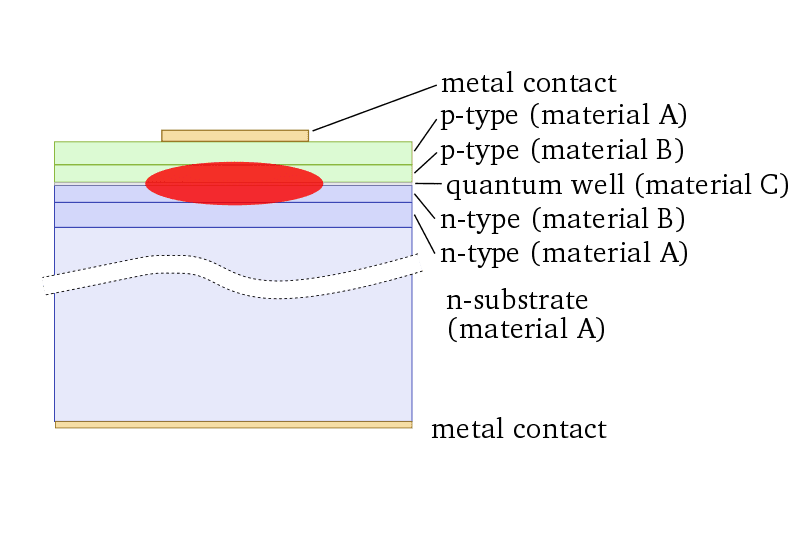
Therefore, in order to confine the light more effectively; an additional pair of confinement layers are added between the initial three layers available (see figure). The newly induced pair of confinement layers have a low refractive index as compared to the central layer (material C). In other words, I can conclude that when you add a double heterojunction laser diode with a quantum well laser diode, you get a Separate Confinement laser diode.
Apart from these above-explained, there are so many other types of laser diodes such as
- Quantum Cascade Laser Diode
- Interband Cascade Laser Diode
- Distributed Bragg Reflector Laser Diode
- External Cavity Diode Laser
- Distributed Feedback Laser Diode
- Vertical Cavity Surface Emitting Laser Diode (VCSEL) etc
Laser diode characteristics curve
The laser diode characteristics curve is nothing but a graphical representation of optical output power on the Y-axis with respect to the input current on the X-axis.
Check out, Alternating Current (AC) vs Direct Current (DC) in Tabular Form
From this graph, it can be clearly observed that; at first, with the gradual increase in the input current, there is a gradual increase in the optical power generated. Once the threshold is crossed (see graph), there is a rapid increase in optical power even for a smaller increase in the input current.
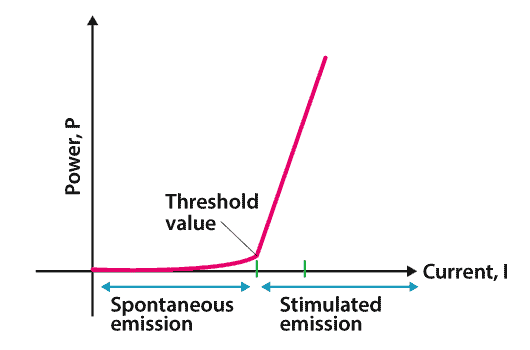
The threshold value is nothing but a divider. Such that, before this threshold point; the output of the optical power is simply due to the spontaneous emission of light. On the other hand, after or above this threshold point, the output power is mostly due to the stimulated emission of light. In fact, from the above figure, it can also be noted that below the threshold point, this graph can be used for the representation of the characteristics curve of LEDs. And on the other hand, if we add the stimulated emission too, we get the laser diode characteristics curve.
Advantages of Laser Diode
- The light produced is highly coherent and monochromatic in nature.
- Consumes less power.
- Small in size.
- The operational cost is low.
- Long-life etc.
Disadvantages of Laser Diode
- Heating problem.
- Highly expensive as compared to LEDs.
- Not suitable for high power applications etc.
Applications of Laser Diode
In the current world scenario, there is a wide range of applications of semiconductor laser diodes in different fields like industrial applications, scientific research, telecommunication, defense industries, medicinal applications, and, consumer electronics, etc. Well, I can’t list them all. But some of them are listed below.
- CD and DVD players.
- Remote control applications.
- Laser Printing and laser scanning.
- Barcode readers.
- In medical machines.
- Spectroscopic sensing.
- Range finders etc.
That’s it for this post. If you like this article, share it if you like it, like it if you share it. You can also find us on Mix, Twitter, Pinterest, and Facebook.
